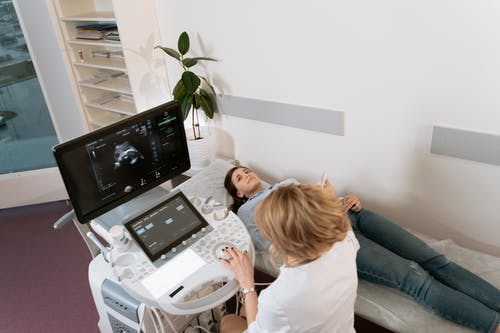When it comes to mastering ultrasound technology, understanding the basic functions and settings of your ultrasound machine is just as crucial as learning anatomy or imaging techniques. The term “knobology” refers to the study and mastery of the ultrasound machine’s controls (or “knobs”) and settings. Knowing how to use these knobs effectively is essential for obtaining high-quality images and making accurate diagnoses.
In this blog post, we’ll provide essential knobology tips to help you get the most out of your ultrasound training experience. Whether you’re a midwife, nurse practitioner, physician assistant, or doctor, these tips will help you feel more confident with your ultrasound machine, improving your learning curve and enhancing your diagnostic skills.
1. Master the Basics of Gain Control
Gain is one of the most important settings on an ultrasound machine. It controls the brightness or darkness of the image, allowing you to fine-tune the overall image quality.
Why It’s Important:
- Gain helps you adjust the ultrasound image’s contrast to make structures easier to identify.
- Too much gain can make the image look “snowy” or overexposed, while too little can make it too dark and difficult to interpret.
Tip for Success:
- Start with Default Gain Settings: When you first start scanning, use the default gain settings provided by the machine. From there, gradually adjust the gain to get a clearer image.
- Tweak Gain for Specific Areas: In different body parts or patient types, you might need to adjust the gain. For example, imaging the abdomen may require a different gain setting compared to imaging the heart. Practice adjusting it in different scenarios to understand what works best.
2. Understand the Depth Control
Depth controls the amount of tissue your ultrasound machine scans. By adjusting the depth, you can either zoom in to focus on a specific area or zoom out to capture a larger region. This is particularly important for visualizing deeper or superficial structures.
Why It’s Important:
- Depth affects the size of the image and the structures you can see.
- It helps ensure that you’re not missing important details or structures at different levels.
Tip for Success:
- Set Depth Appropriately: Start with a mid-range depth and adjust depending on the area you are imaging. If you are imaging a large structure like the liver, you may need a deeper setting. For smaller structures like blood vessels or the fetus in early pregnancy, use a shallow depth.
- Zoom In/Out as Needed: If you are unable to clearly visualize a structure, adjust the depth to zoom in and refine your view.
3. Master Focus Control
Focus is essential for obtaining clear, sharp images at specific depths within the body. Ultrasound machines typically have a focus control feature that allows you to adjust the focal point of the image.
Why It’s Important:
- Focus allows you to sharpen the image at different levels of tissue, which is key to obtaining high-quality diagnostic images.
- Inadequate focus can result in blurry or distorted images, leading to missed diagnostic information.
Tip for Success:
- Adjust Focus for Clarity: When scanning, adjust the focus to the depth where the area of interest lies. The focal zone should always be placed where you want the best image quality.
- Use Multiple Focus Zones: Some advanced ultrasound machines allow for multiple focus zones. If available, use this feature to ensure you’re getting the sharpest image throughout different layers of tissue.
4. Learn the Role of Time Gain Compensation (TGC)
Time Gain Compensation (TGC) is a feature that allows you to adjust the gain at different depths to ensure that your image is evenly illuminated from top to bottom. The image may appear darker at deeper depths because the ultrasound waves lose energy as they penetrate the body. TGC compensates for this loss by adjusting the gain at specific depths.
Why It’s Important:
- TGC is useful for creating more balanced images when scanning deeper structures or areas with varying tissue densities.
- It helps enhance the quality of the image by boosting the gain in deeper tissues while reducing it in superficial layers.
Tip for Success:
- Adjust TGC Gradually: Don’t just increase the gain for the whole image; focus on adjusting the TGC to optimize the image’s brightness and contrast at specific depths.
- Use TGC for Specific Areas: If you notice certain areas of your scan are too dark or light, use TGC to adjust gain levels for better contrast and visualization. Be mindful of both the shallow and deep layers of tissue.
5. Optimize Image Resolution with Frequency Control
Frequency controls the resolution and depth of your ultrasound images. Higher frequencies provide better resolution but are limited in their ability to penetrate deeply, while lower frequencies provide greater penetration but with less resolution. Choosing the right frequency is key for producing clear, high-quality images.
Why It’s Important:
- Frequency adjustments help balance between image resolution and the depth of structures you are imaging.
- High-frequency probes are ideal for shallow structures (like muscles or tendons), while low-frequency probes are better for deeper organs (like the liver or kidneys).
Tip for Success:
- Select the Right Frequency for the Task: Use high-frequency settings for imaging superficial structures and low-frequency settings for deeper organs or the abdomen.
- Balance Resolution and Depth: For larger structures, such as the heart or bladder, you may need to lower the frequency to ensure good depth penetration while sacrificing some resolution. For small or superficial structures like the thyroid, increase the frequency to get the best resolution.
6. Use the Freeze and Measure Functions Effectively
The “freeze” function is invaluable for capturing still images during an ultrasound scan, allowing you to pause the image and evaluate it more thoroughly. Once you have a clear image, you can use the measurement tools to assess the size, shape, or depth of certain structures.
Why It’s Important:
- The freeze button helps you hold a moment and get a precise view of the anatomy, preventing motion blur from patient movement.
- Measurement tools help in making accurate calculations or assessments, such as measuring the size of a tumor or fetal development.
Tip for Success:
- Use Freeze for Clarity: Always freeze the image if you need to take a closer look or record important findings.
- Utilize Measurement Tools: Most ultrasound machines allow you to measure structures in 2D or 3D. Learn how to use these tools to measure organ size, blood flow, or other critical features. This will increase your diagnostic accuracy.
7. Experiment with Different Imaging Modes
Ultrasound machines come with various imaging modes that can help you visualize tissues and structures in different ways. Common modes include B-mode (Brightness mode), Doppler (for blood flow), M-mode (motion mode), and 3D/4D imaging.
Why It’s Important:
- Different imaging modes allow you to obtain specific diagnostic information that may be necessary for accurate interpretation.
- Mastering these modes will enhance your overall scanning capabilities.
Tip for Success:
- Understand the Purpose of Each Mode: Familiarize yourself with when to use each imaging mode. For example, use B-mode for general imaging, Doppler for evaluating blood flow, and M-mode for heart rhythm assessments.
- Practice Switching Between Modes: During training, practice switching between these modes to understand the differences in image quality and use them according to your clinical needs.
8. Don’t Forget About Patient Comfort and Positioning
While knobs and settings are essential for obtaining quality images, it’s important to remember that patient comfort and positioning also play a significant role in achieving clear and accurate results. Misalignment or discomfort can cause the patient to move, which affects the clarity of your images.
Why It’s Important:
- Proper patient positioning ensures better visualization of the area being scanned.
- Comfortable positioning reduces movement, which can lead to blurred images.
Tip for Success:
- Position the Patient Correctly: Before adjusting the knobs, ensure that your patient is in the optimal position for the scan. This might involve adjusting the bed, using pillows for comfort, or having the patient lie in a specific position.
- Communicate with the Patient: Make sure your patient understands what’s happening during the scan, which can help reduce anxiety and movement.
Conclusion: Mastering Knobology for Better Ultrasound Training
Understanding ultrasound knobology is a crucial aspect of becoming proficient in ultrasound diagnostics. By mastering the controls on your ultrasound machine, including gain, depth, focus, TGC, and frequency, you’ll be able to capture high-quality images, improve your diagnostic accuracy, and ultimately enhance patient care.
As you continue your ultrasound training journey, take the time to practice with different settings and experiment with the knobs to see how they impact your images. By doing so, you’ll build confidence in your skills and become more efficient in your use of ultrasound technology. At Ultrasound Trainings, we offer expert ultrasound training courses designed to help you develop these skills and more. Our programs provide in-depth instruction on how to use ultrasound machines effectively, giving you the tools you need to succeed in your medical career. Contact us today to learn more about our training opportunities!


